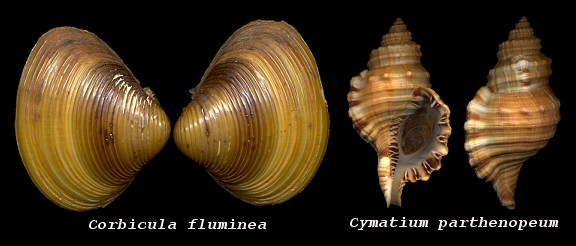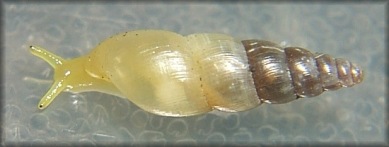| Thoughts On the Peregrinations Of Three Mollusks |
| By Harry G. Lee |
| Our new president's recent fascinating report on the local occurrence of Cymatium parthenopeum (von Salis, 1793) (Neopolitan Triton), stirred me into a little bit of library-browsing. I would like to share with you some facts and ruminations which may shed a small ray of light on the hows and whys of molluscan distribution. It happens that in our immediate vicinity are found three species of mollusks which possibly qualify as the most widely-distributed representatives of their habitat. They are Corbicula fluminea (Müller, 1774) (Asian Clam), Allopeas gracile (Hutton, 1834) (Graceful Awlsnail), and Cymatium parthenopeum, representing fresh water, land, and the ocean bottom respectively. |
|
|
| Corbicula fluminea is a recent visitor to this area. After its appearance in the American Northwest about forty years ago, it has inexorably spread south, east, and north again girdling the continent from the Columbia River to Baja California east to Florida and New Jersey. A barrage of scientific papers has documented its appearance in river system after river system, at times step-wise, and at others by great leaps. Most of the major rivers of Florida have astronomically large colonies of this one to two inch clam, and, as has been noted elsewhere, its impact on our own native bivalves, especially the Unionoidea, may well be detrimental. Why has little Corbicula exploited such a vast area so rapidly? Well, two important factors seem to be: (1) it is an exotic species and has apparently left its natural enemies back home in the Orient, and (2) its inherent biologic characteristics are suited to such globe-trotting. Let's postpone thoughts on exoticism for now and discuss Corbicula in general biologic terms. |
|
|
|
Allopeas gracile (Hutton, 1834) |
| Firstly, Corbicula,
like our other examples of widely-distributed mollusks, tolerates
a wide variety of habitats and temperatures. Equally important
are its reproductive characteristics. which differ considerably
from our native mussels (as discussed at the September, 1974
meeting), The vast majority of our fresh water mussels (Unionoidea)
are of separate sexes and as larvae are parasitic on fish. For
these reasons chance introduction into new areas by, say, the
agency of birds or even man are not likely to succeed. A single
living example, unless a gravid female (too heavy for most birds
to tote), could not successfully reproduce. Even if reproduction
occurred, there would be no assurance that a fish which was (1) a
suitable host would (2) appear at the proper time and (3) be
successfully infected by the larvae. It is for these reasons that
our pearly mussel species are generally restricted to a few (or
less) usually closely-related river systems. The much maligned
Asiatic Clam, on the other hand, doesn't worry over such matters.
Being capable of self-fertilization, it only takes "one to
tango," therefore, even a single juvenile could eventually
produce a new colony. Further, there is no need for helpful fish
as the offspring develop directly. Therefore, one can envision a
bird such as a duck transporting (possibly, but not necessarily,
through his digestive tract) a pea-sized Corbicula
a few miles from, say, Macclenny to Jacksonville. A
short hop like that means more than a few
miles. Zoogeographically it is the bridging of an entire river
system since the Suwannee system drains Macclenny. After such a
trip all indications are that Corbicula
spreads like wildfire in all directions and demonstrates
astronomical population growth. At present, certain local areas
such as Black Creek appear to be free of the Asiatic Clam, but it
is in the upper reaches of the St. Johns. Careful observations by
collectors may help determine the impact on local mussels when
the inevitable appearance of Corbicula
occurs in places like Black Creek. One of our back yard snails, Allopeas gracile was said by the late H. A. Pilsbry to be perhaps the most widely-distributed terrestrial snail in the world. There are certain biologic similarities between Corbicula and this ten-millimeter Terebra-look-alike which may aid in our understanding of why this is so. Besides being an South American native, Allopeas is also hermaphroditic, but then so are the majority of the terrestrial snails in most of this range. Also important in the spread of these creatures through the tropics and temperate zones is that notion of "exoticism" we mentioned earlier. For centuries man has produced and witnessed, usually to his dismay, successful introductions of living things across once-natural barriers. As we look around Jacksonville, stark example: are numerous: water hyacinths (South America), pigeons and starlings (Europe), Fire Ants (South America), and Garden Slugs (Europe). Why is it such creatures succeed so strikingly? Firstly, they are extracted from an environment in which the population was held in balance by interaction with natural enemies. For mollusks like certain slugs and our Allopeas, these included predators such as birds, rodents, beetles, and other mollusks on the one hand, and parasites such as flat worms and protozoa on the other. When a Allopeas is brought into the United States on an South American plant, its predators are left behind, and chances are that the full array of parasites responsible for its place in its native ecosystem don't make the trip with him. Such was probably the situation when the giant African snail Lissachatina fulica (Bowdich, 1822) was introduced into the Hawaiian Islands as a food source in 1936. A few years later, its establishment there had biologists importing predators including snails like Gonaxis and our own Euglandina rosea (Férussac, 1821) and even pondering potential parasites to curb the unbridled growth and spread of this snail. It seems that Hawaii had no such creatures of its own awaiting the ill-contrived arrival of Lissachatina. I believe that most of our introduced gastropods found things in about the same shape as did Lissachatina. Fortunately nobody need fret over most of them (including our Allopeas) because they don't create the disturbance that the up-to-eight inch Lissachatina snails did (and this includes auto accidents from the slimy remains on highways). Another advantage enjoyed by Old World introductions from starlings to slugs was a head start in adaptation to the urban habitat. Certain animal species such as the English Sparrow and Escargot were able to adapt to human-altered environments in Europe. After centuries, perhaps millennia, of adaptive coexistence with man there should be little surprise that, when brought here, they hook up that same environmental niche. Native American species simply were at an evolutionary disadvantage. This "urbanophilia" (or city-dwelling habit) is typical of most exotic land gastropods and has probably (repeatedly) helped Allopeas gain a foothold. Now at last to our offshore triton, C. parthenopeum. Club President Charlotte Lloyd indicated that the type locality is recapitulated in the name, an archaic equivalent of Naples, Italy. The irony of geographic reference notwithstanding, what is a Mediterranean mollusk doing on the local sunken vessel Casablanca? We'll address that shortly, but first let's look at the entire range of this mollusk. Numerous sources including correspondence, published works, and, of course, specimen shells themselves allow this synopsis: north-and southwest Mediterranean through the entire west African coast, through South Africa, East Africa, India, Taiwan, Japan, at least three fourths of Australia, New Guinea, north island of New Zealand, Hawaii, Baja California to the Galapagos and Cape Hatteras to Uruguay. A range across this staggering expanse of sea is matched only by a few pelagic snails like Janthina, which drift about at the mercy of the elements. A like characteristic of the Neapolitian Triton in fact accounts for its extensive distribution. Larval marine gastropods (veligers) usually take only a brief swim before settling into the sedentary life with which we usually identify them. Just a few years ago, however, Scheltema reported that the veligers of C. parthenopeum swam about for three months. That's enough to cross the Atlantic (as the author indicates). In fact, that probably is long enough to almost explain the unparalleled distribution of this snail. The passage of larvae between the tropical Western America and other portions of its range must not occur often - considering the distances involved and the prevailing currents of that region. Perhaps this has allowed sufficient isolation of the Panamic C. parthenopeum to develop subspecific characteristics as is the contention of experts like Beu and Keen. It is conceivable, but not too likely, that C. parthenopeum reached the western New World by crossing the Central American isthmus in Miocene time. We know that Pliocene (say 5,000,0000 year-old) fossils of this triton so closely resemble the modern descendants that they are considered conspecific. Honorary club member Dr. William Clench has pointed out that this retarded rate of conchological evolution must be considered in evaluating the cosmopolitan ranges of the tritons (Ranellidae). Although C. parthenopeum is undisputedly the most eclectic of the lot, the great majority of our other Florida tritons are also found in the Indo-Pacific province. Such is not true, however, of the western American species, and this is a most interesting discrepancy, one which may be discussed in a subsequent Shell-O-Gram. It is obvious from the previous discussion that a variety of biologic characteristics play a role in the distributions of mollusks: reproductive habits, life history, natural enemies, and adaptability to the environment in addition to the mechanical transport. Some are of general importance whereas others operate only in special cases. Certainly these features are not unique to the mollusks, but it is clear from the record that they have exploited them as well as other living creatures, and better than most. These humble organisms have encircled the globe and remained in residence for one-half billion years, a feat achieved by very few other living things. Little wonder that the study of how the mollusks do "their things" is such a fascinating pursuit. *Taxonomy in the above article has been updated from that originally published in 1976. |

